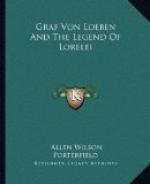[67] Cf. Elster edition, IV, 406-9. The
circumstantial way in which
Heine retells this story is
almost sufficient to lead one to
believe that he had Schreiber
at hand when he wrote this part of
Elementargeister; but he says
that he did not.
[68] Discussion as to the first conception of Heine’s
Rabbi are
found in: Heinrich
Heines Fragment; Der Rabbi von Bacharach,
by Lion Feuchtwanger, MUenchen,
1907; Heinrich Heine und Der Rabbi
von Bacharach, by Gustav
Karpeles, Wien, 1895.
[69] The poem is one of the Junge Leiden, published
in 1821, Elster
(I, 490) says: “Eine
bekannte Sage, mit einzelnen vielfach
wiederkehrenden uralten ZUegen,
dargestellt In Simrocks
Rheinsagen.”
Simrock had, of course, done nothing on the
Rheinsagen in 1821,
being then only nineteen years old and an
inconspicuous student at Bonn.
Walzel says (I. 449.): “Mit einem
andern Ausgang ist die Sage
in dem von Heine vielbenutzten
Handbuch fUer Reisende
am Rhein von Aloys Schreiber (Heidelberg,
1816) Ueberliefert.”
The edition of this work in the New York
Public Library has no printed
date, but 1818 is written in. Walzel
may be correct. The outcome
of Heine’s poem is, after all, not so
different: In Schreiber,
both brothers relinquish their clalms to
the girl and remain unmarried;
in Heine the one kills the other
and in this way neither wins
the girl.
[70] It is the same story as the one told by Bulwer-Lytton
in his
Pilgrims of the Rhine.
chap. xxiv.
[71] All through the body of Schreiber’s Handbuch,
there are
references to the places and
legends mentioned in Heine’s
Rabbi. On Bacharach
there is the following: “Der Reisende,
wenn er auch nur eine Stunde
in Bacharach verweilt, unterlasse
nicht, die Ruinen von Staleck
zu besteigen, wo eine der schOensten
Rheinlandschaften sich von
seinen Blicken aufrollt. Die Burg von
sehr betrAechtlichem Umfang
scheint, auf den TrUemmern eines
ROemerkastells erbaut.
Die, welche die Entstehung derselben den
Hunnen zuschreiben, well sie
in Urkunden den Namen Stalekum hat,
sind in einem Irrtum befangen,
denn Stalekum oder Stalek heisst
eben so viel als StalbUehl,
oder ein Ort, wo ein Gericht gehegt
wurde. Pfalzgraf Hermann
von Staleck, starb im 12ten Jahrhundert;
er war der letzte seines Stammes,
und von ihm kam die Burg, als
KOelnisches Lehen, an Konrad
Von Staufen.”
[72] To come back to Heine and Loeben, Herm.
Anders KrUeger says (p.,
147) in his Pseudoromantik:
“Heinrich Heine, der Ueberhaupt
Loeben studiert zu haben scheint,”
etc. He offers no proof. If one
wished to make out a case
for Loeben, it could bo done with his
narrative poem “Ferdusi”
(1817) and Heine’s “Der Dichter Ferdusi.”
Both tell about the same story;
but each tells a story that was
familiar in romantic circles.




